Contents
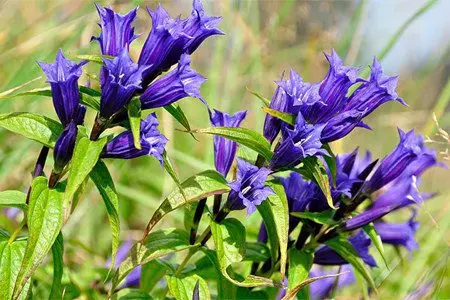
Gentian is a genus of perennial, much less often – annual herbs or shrubs, the height of which is from 20 to 150 cm. The plant belongs to the gentian family, in which there are about 400 species. Currently, the plant is common in the mountainous regions of Europe, Asia, and America.
In the vast majority of cases, the color of gentian is blue, blue (various shades) and purple. There are species with yellow and white flowers. The flowering time depends on the type of gentian, as certain species bloom in spring, the rest in summer or autumn.
Gentian root is of medical value. It is used for fluid retention in body tissues, for the treatment of inflammatory processes, infected wounds. It is known about the ability of gentian to neutralize animal poisons.
Gentian root – what is it?
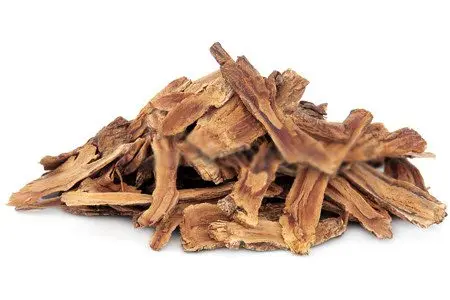
The root of the gentian is small, dense, yellow-brown in color. Thinner, cord-like roots depart from the central part. The root is dried, used for the preparation of tinctures, extracts, tea. In pharmaceuticals, gentian root powder is compressed into tablets that can be dissolved in water. The finished product can be taken orally or used externally.
In folk medicine, an aqueous infusion of gentian root is used. It is believed that it is effective in the treatment of congestion of the liver, spleen, stomach diseases. Compresses from the root of gentian and vinegar help with inflammatory processes of the skin, poorly healing purulent wounds [1].
The bitter taste of the root fully justifies the name of the plant. Due to natural bitterness, it has a tonic effect on the digestive system, stimulates the secretory function of the stomach, liver, gallbladder. In the alcohol industry, gentian root is used for the production of aperitifs and digestifs. Aperitifs are served before meals to stimulate the appetite. Digestifs are drunk after meals to facilitate digestion.
The benefits of gentian
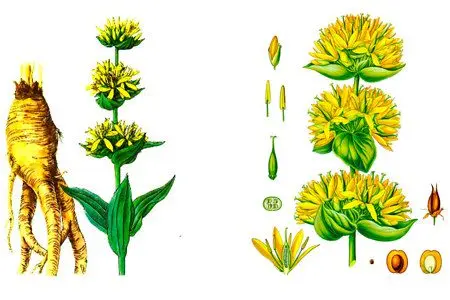
Most types of gentian have healing properties, knowing about which, traditional healers use them in their medical practice. The aerial part and roots of gentian contain a number of biologically active substances that have a positive effect on the body in various diseases.
The study of the composition of the gentian root showed the presence in its structure of high doses of iridoids, secoiridoids, xanthones and flavonoids – organic substances that have the main therapeutic effects of the plant. The concentration of active compounds depends on the type of plant, the collection period, the drying process. These features explain why not every plant composition has the same properties.
The pharmacological properties of the plant are primarily determined by the presence of bitter substances – glycosides, which have a positive effect on the functioning of the gastrointestinal tract and stimulate appetite. Glycosides also have an antispasmodic effect.
In the root of gentian, gentiopicrin, amarogentin, as well as several other bitter glycosides have been isolated: amarosverin, amaropanin, svertiamarin. An alkaloid called gentianin was found in the root part of the plant, the list of useful substances was supplemented with other alkaloids – pyridine derivatives: gentsialutin, gentsianidin, gentiopunctin, gentioflavin.
Gentianin helps to suppress cough, convulsions, reduce fever, and also has a sedative and anti-inflammatory effect.
In addition to the listed substances, aromatic compounds, tannins and resinous substances, pectins, ascorbic acid, inulin were found in the roots of gentian (for example, yellow gentian). Fatty oils and sugars (gentianose trisaccharide and sucrose disaccharide) were also found in the roots.
In many types of gentian, in their root part, 13 phenolcarboxylic acids were found. The most common for this type are o-hydroxyphenylacetic, pyrocatechuic, m-hydroxybenzoic and homoprotocatechuic, ferulic acids, due to which the evacuation function of the stomach is enhanced.
Experimentally, scientists have obtained results confirming some of the medicinal properties of gentian.
3 Scientifically Proven Healing Benefits of Gentian
1 Relieves symptoms of arthritis
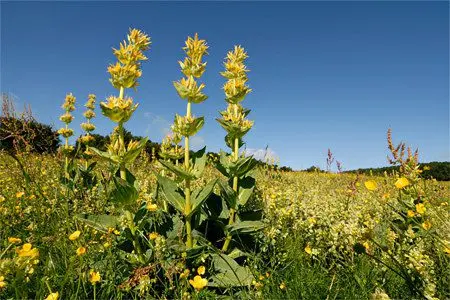
Rheumatoid arthritis is a chronic joint disease that is accompanied by severe inflammation. Rheumatoid arthritis is based on an autoimmune process in which immune cells attack healthy cells in the body. In addition to inflammation, the disease is characterized by severe pain, swelling in the area of the affected joints.
Gentian root has powerful anti-inflammatory properties, which means it can significantly improve the well-being of patients. The structure of the plant contains gentiopicroside, an iridoid that affects the course of rheumatoid arthritis. [2].
Laboratory experiments in animals have demonstrated the ability of gentiopicroside to influence the inflammation characteristic of arthritis. In all rodents, there was a decrease in the change in cells that cause the destruction of cartilage tissue. [3], [4].
One study looked at the effects of gentian root on the well-being of rats with arthritis. It turned out that the improvement in the condition of the affected joints is associated with a decrease in the level of pro-inflammatory markers under the influence of gentiopicroside. [5].
2 Helps in the treatment of sinus infections

Gentian root is included in the formulation of pharmaceutical preparations traditionally used to treat sinusitis. For example, Sinupret drops have been prescribed to treat nasal infections for over 80 years. The composition of Sinupret also includes elderberry flowers, primrose, sorrel, verbena [6].
One of the studies on the properties of Sinupret was conducted with the participation of 184 children. The experimental group of participants was daily dripped into the nose Sinupret and asked to gargle with saline. Ten days later, all children showed improvement in well-being, relief of nasal breathing, and relief of mucus discharge. In the control group of children who were only offered to gargle with saline, there were no significant changes in well-being. [7].
Clinical observations confirm that the use of gentian root alleviates the symptoms of sinus infections – congestion, headache and facial pain. All unpleasant symptoms appear against the background of inflammatory processes in the paranasal sinuses.
Experts believe that the therapeutic effect of gentian is realized due to the high content of iridoids and flavonoids. It has been experimentally confirmed that the use of the root of the plant facilitates the removal of mucus from the nose. [8].
3 Improves digestion
Gentian root contains iridoids and secoiridoids, which stimulate appetite and help protect the digestive tract from negative factors. Among these compounds, amarogentin, amarosverin, gentiopicroside should be distinguished. Vegetable bitterness stimulates the production of saliva, gastric juice, which encourages the consumption of more food and facilitates digestion. [9].
The stimulant qualities of gentian have been studied in children with anorexia. 50 participants were divided into two groups. The experimental sample received gentian root extract daily. All of the children in this group experienced an improvement in appetite, weight gain, and higher calorie intake after two months. The placebo group showed no positive results [10].
Due to its ability to increase appetite, gentian root is a traditional ingredient in many aperitifs and bitter liqueurs served before meals. The use of formulations based on gentian root is recommended for violations of the stomach, nausea, flatulence [11].
[Video] Benefits of gentian, application:
Recipes for decoction, infusion and tincture
decoction
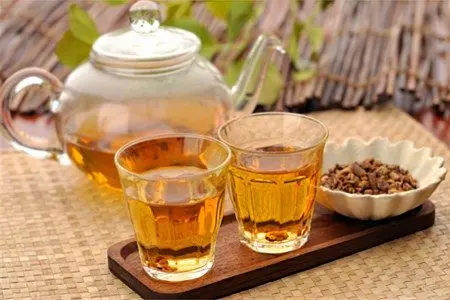
Recipe № 1: 1 tablespoon of dried and ground gentian root should be poured into a bowl and poured with water (250 ml), then simmer for 10 minutes. It is recommended to take the remedy 15-20 minutes before meals, 20 ml. The decoction is designed to increase appetite.
Recipe № 2: 3 teaspoons of dry raw materials should be poured with water (700 ml), bring to a boil, simmer for 15 minutes, then leave for at least two hours, and then strain. Take the medicine 15-20 minutes before meals for 0,5 cups. The decoction is intended for the treatment of rheumatism, arthritis, gout.
Recipe № 3: It is necessary to take 5 tablespoons of raw gentian root and 3 tablespoons of oak bark. Boil the resulting mixture for 10 minutes. This decoction helps to solve the problem with sweating feet. Foot baths are recommended to be done daily before going to bed.
Infusion
Gentian infusion is recommended for diseases of the liver, bile ducts.
To prepare the medicinal composition, it is necessary to pour a tablespoon of dry gentian roots with 500 ml of boiling water, leave overnight to infuse. You can use a thermos.
Strained infusion is taken half a glass three times a day before meals.
Tincture
Gentian root can be infused with alcohol or wine. In the first case, take 100 grams of plant base and pour 1 liter of 96% ethyl alcohol. The container is closed with a lid and placed in a dark place. A week later, the tincture is ready for use.
Alcohol tincture is taken three times a day, 30-35 drops, previously dissolved in a small amount of water.
Wine tincture is prepared from 50 grams of gentian roots and 500 ml of strong red wine. The ingredients are mixed in a bottle, corked and infused in a dark place for three weeks.
[Video] Sow Gentian just like that! Germination success is guaranteed:









